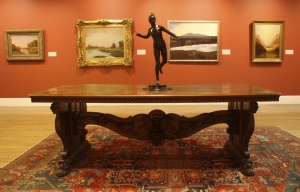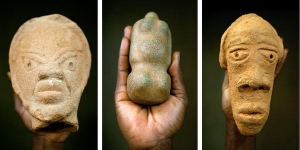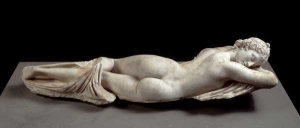|
Displaying items by tag: antiquities

After twenty-two years, Nicholas Capasso will be leaving his post at the deCordova Sculpture Park and Museum in Lincoln, MA. Capasso, who is currently the deCordova’s deputy director for Curatorial Affairs, has been named the new director of the Fitchburg Art Museum and will start his latest venture on December 3.
During his time at the deCordova, Capasso has overseen a permanent collection that included 3,500 objects, changing gallery exhibitions, and an outdoor sculpture park. He helped to bring recognition to the institution and to reposition it as an important contemporary museum.
While Capasso specializes in contemporary art, he is eager to work with the Fitchburg Art Museum’s collection that spans more than 5,000 years and includes American and European paintings, prints, drawings, ceramics, decorative arts, and Greek, Roman, Asian, and pre-Columbian antiquities. The Museum’s collection, which is housed between twelve galleries, includes works by William Zorach, John Singleton Copley, Joseph Stella, Edward Hopper, Charles Burchfield, Charles Sheeler, Walker Evans, and Georgia O’Keeffe.
Capasso will take over the role of director from the soon-to-be-retired Peter Timms who has held the position since 1973.
Art fairs like the Paris Biennale, opening Friday, bring out the two salient features of the new art market: Prices are nearly all beyond the reach of average budgets, and most of the youngest dealers are already in their 40s or 50s.
World records tumbled during the past season, prompting lyrical celebrations in the news media. Auction houses love it. Should we too, seeing the records as homage paid by growing numbers of art lovers? Hardly. Seemingly paradoxical in recessionary times, records merely highlight the huge price rise of the art of the past over five decades.
True, this increase has not been uniform. Even as records are being set, wild estimates fail to be matched and some works sell at levels that leave their consignors with severe losses.
Over the last five years, the Cleveland Museum of Art has been at work on one of the largest building programs of any art institution in the country, a $350 million project that has been unveiled in sleek new stages and will be completed by 2013, adding 35,000 more square feet of gallery space.
But the museum has also been building in less visible ways and is set to announce on Monday the acquisition of two high-profile ancient artifacts that seem certain to draw attention not only to the institution’s expansion but also to the complicated long-running debate about antiquities collecting by museums.
If you pay attention either to China or the art market, you’ve probably heard the story: China last year became – according to art industry experts – the world’s largest market for art and antiques, surpassing the USA.
Well, here’s a shocker: it isn’t. Not even close.

Djenne-Djenno, one of the best-known archaeological sites in sub-Saharan Africa, spreads over several acres of rutted fields near the present city of Djenne in central Mali. The ruts are partly caused by erosion, but they’re also scars from decades of digging, by archaeologists in search of history and looters looking for art to sell.
These days, with Mali in the throes of political chaos, it’s unlikely that anyone is doing much work at all at the site, though history and art are visible everywhere. Ancient pottery shards litter the ground. Here and there the mouths of large clay urns, of a kind once used for food storage or human burial, emerge from the earth’s surface, the vessels themselves still submerged.
The image of an abandoned battlefield comes to mind, but that’s only half-accurate. Physical assaults on Djenne-Djenno may be, at least temporarily, in abeyance. But ethical battles surrounding the ownership of, and right to control and dispose of, art from the past rage on in Africa, as in other parts of the world.
A few weeks ago the Museum of Fine Arts, Boston, announced the acquisition of an American private collection of 32 exquisite bronze and ivory sculptures produced in what is now Nigeria between the 13th and 16th centuries. Within days the Nigerian National Commission for Museums and Monuments claimed, via an Internet statement, that the objects had been pillaged by the British military in the late 19th century and should be given back.
More chilling were reports last month of cultural property being destroyed in Timbuktu, Mali, some 200 miles north of Djenne. Islamist groups, affiliated with Al Qaeda, have singled out Sufism, a moderate, mystical form of Islam widespread in Mali, for attack. In Timbuktu, with its Koranic schools and manuscript libraries, they have begun leveling the tombs of Sufi saints, objects of popular devotion.
In short, the wars over art as cultural property take many forms: material, political and ideological. On the surface the dynamics may seem clear cut, the good guys and bad guys easy to identify. In reality the conflicts are multifaceted, questions of innocence and guilt often — though not always — hard to nail down. In many accounts Africa is presented as the acted-upon party to the drama, the loser in the heritage fight, though such is not necessarily the case, and it certainly doesn’t have to be, and won’t be if we acknowledge Africa as the determining voice in every conversation.

One year on from the collapse of the five-year trial in Rome of Marion True, the former antiquities curator of the Getty, the directors of US museums that possess antiquities collections and the curators who are responsible for them face a multitude of challenges, one of which is the potentially negative publicity surrounding claims for the restitution of artefacts. An ordeal by trial in an Italian court is another (True was in the dock charged with conspiring to receive antiquities that had been illegally excavated and exported). In June 2010, it emerged that the public prosecutor’s office in Rome was undertaking a preliminary investigation into another American curator of antiquities, Michael Padgett from Princeton University Art Museum, along with former New York antiquities dealer Edoardo Almagià and two other co-defendants.
Although the Padgett case has gone quiet, the issue of museums’ complicity in looting, especially from Italy but increasingly from nations around the world, refuses to go away. The recent publication of Chasing Aphrodite (which focuses on decades of Getty acquisitions) reignited the debate, especially in the US. The book’s authors, Jason Felch and Ralph Frammolino, were widely quoted as saying: “For the past 40 years, museum officials [in the US] have routinely violated the spirit, if not the letter, of the Unesco treaty [designed to prevent looting], buying ancient art they knew had been illegally excavated and spirited out of source countries.”
So where does this leave museums with antiquities collections? Will curators work in a climate of fear, worried about their professional reputations or foreign prosecutions over past acquisitions? What will they do with collections, many of which contain objects without watertight provenance? At worst, some fear that antiquities collections could be sidelined, with directors and their trustees reluctant to invest in or research them.
Others, however, feel that the worst is now over, and that a new spirit of international co-operation is beginning to blossom. Perhaps in a show of confidence, the Cleveland Museum of Art reinstalled its collection of Greek and Roman art in 2010, and the Museum of Fine Arts (MFA) in Boston is renovating its ancient coin and jewellery galleries, says its director, Malcolm Rogers.
Returning loot
The plundering of Italy’s archaeological sites, which escalated in the 1970s, feeding the trade in looted objects, has become a cause célèbre—exacerbated by the fact that some of the best works have ended up in museums. Investigations of collections at major American museums have resulted in the restitution of numerous items to Italy: the first round of agreements in 2006 and 2007 included the return of 21 antiquities from the Metropolitan Museum of Art, New York; 40 from the J. Paul Getty Museum, Los Angeles; 13 from the Museum of Fine Arts, Boston; and eight from the Princeton University Art Museum. In 2008, 13 (in addition to one Gothic processional cross) were returned by the Cleveland Museum of Art. The Minneapolis Institute of Arts is in the process of returning its 2,500-year-old volute krater to Italy.
The Italian Ministry of Culture has responded, rewarding institutions by sending works to US museums on long-term loans and co-operating in special exhibition programmes and provenance research. “Our ability to borrow amazing works of art like the Sleeping Hermaphrodite, which has left Italy only once before, could not have happened without partnerships and our behaving responsibly,” Rogers says. It is one of 13 significant loans—nine from Rome and Naples—in “Aphrodite and the Gods of Love” (until 20 February 2012). Expectations of loans are an integral part of today’s restitution process. Even before the MFA returned the upper half of Weary Herakles to Turkey in September 2011, the New York Times reported that the museum hoped to borrow its lower half from the Antalya Museum.
Nowhere is international cultural co-operation more apparent than at the Getty, paradoxically the institution targeted in particular by the Italian authorities and subsequently the media in the 1995 antiquities scandal that led to the 2005 indictment of True. The Getty signed a “major long-term cultural collaboration” with Sicily in February 2010 and an agreement “creating a framework for cultural co-operation” with Greece in September 2011. The Getty and the Cleveland Museum of Art are now planning a major 2013 exhibition focusing on Sicily’s Classical and Hellenistic periods.
“The responsibility of 21st-century museum staff is to realise the fluidity of shared stewardship,” says Michael Conforti, the director of the Sterling and Francine Clark Art Institute and president of the Association of Art Museum Directors (AAMD) from 2008 to 2010. This means caring for objects that belong in theory to “an international museum community”. Creating a network “of institutions linked with ones abroad or archaeological sites in source countries” is “where the world is going” and will result in richer displays of antiquities. But, he adds, it will take time, as the American public needs to adjust to this new concept and having “periodic access to antiquities”.
|
|
|
|
|